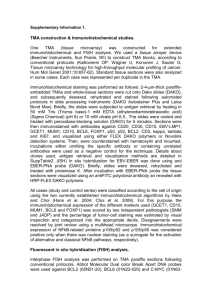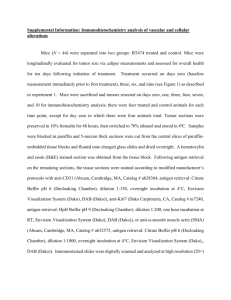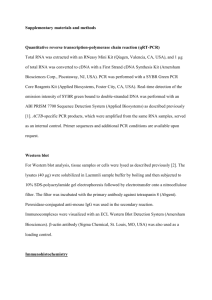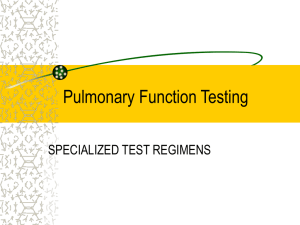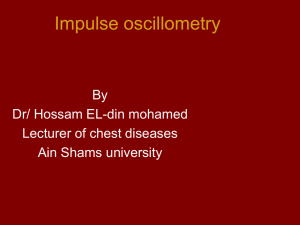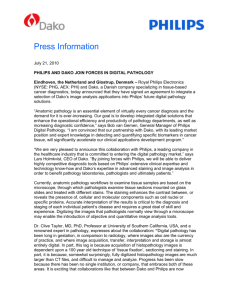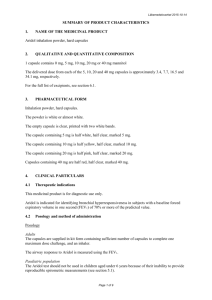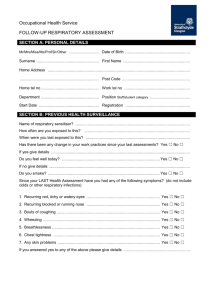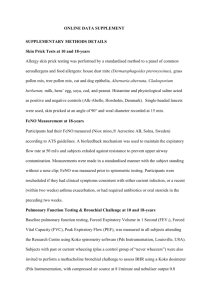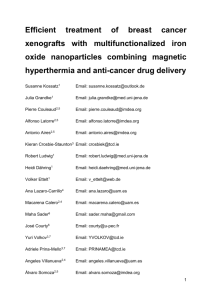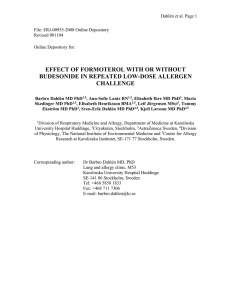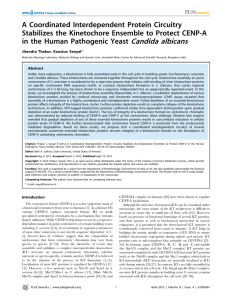cea12609-sup-0001-Supinfo
advertisement
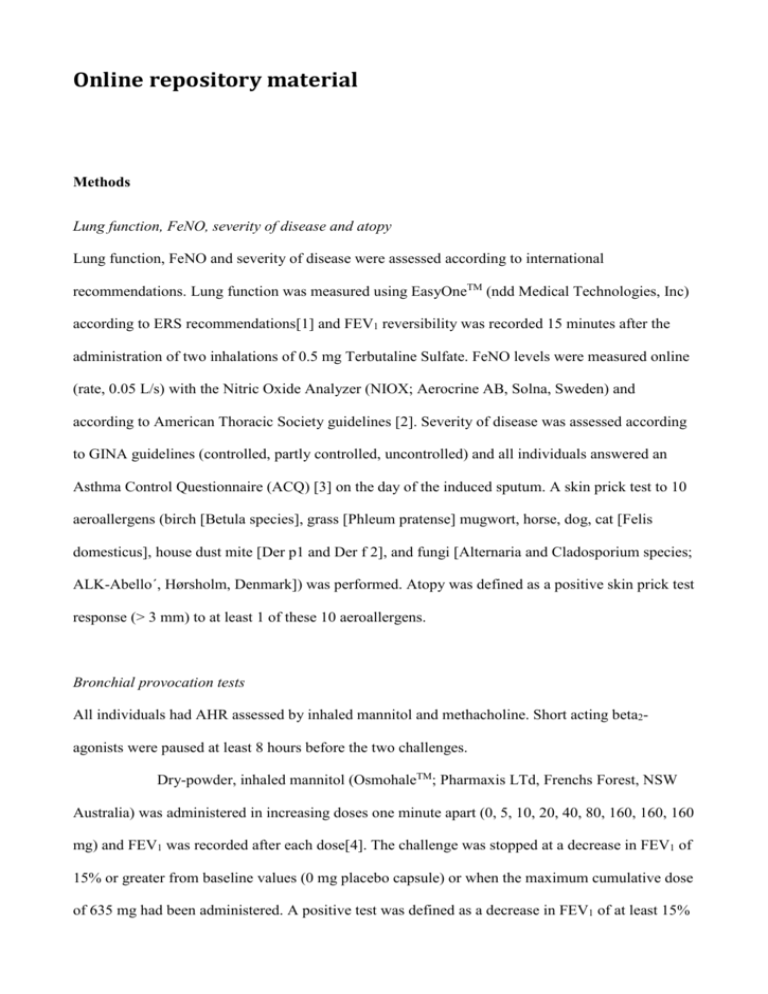
Online repository material Methods Lung function, FeNO, severity of disease and atopy Lung function, FeNO and severity of disease were assessed according to international recommendations. Lung function was measured using EasyOneTM (ndd Medical Technologies, Inc) according to ERS recommendations[1] and FEV1 reversibility was recorded 15 minutes after the administration of two inhalations of 0.5 mg Terbutaline Sulfate. FeNO levels were measured online (rate, 0.05 L/s) with the Nitric Oxide Analyzer (NIOX; Aerocrine AB, Solna, Sweden) and according to American Thoracic Society guidelines [2]. Severity of disease was assessed according to GINA guidelines (controlled, partly controlled, uncontrolled) and all individuals answered an Asthma Control Questionnaire (ACQ) [3] on the day of the induced sputum. A skin prick test to 10 aeroallergens (birch [Betula species], grass [Phleum pratense] mugwort, horse, dog, cat [Felis domesticus], house dust mite [Der p1 and Der f 2], and fungi [Alternaria and Cladosporium species; ALK-Abello´, Hørsholm, Denmark]) was performed. Atopy was defined as a positive skin prick test response (> 3 mm) to at least 1 of these 10 aeroallergens. Bronchial provocation tests All individuals had AHR assessed by inhaled mannitol and methacholine. Short acting beta2agonists were paused at least 8 hours before the two challenges. Dry-powder, inhaled mannitol (OsmohaleTM; Pharmaxis LTd, Frenchs Forest, NSW Australia) was administered in increasing doses one minute apart (0, 5, 10, 20, 40, 80, 160, 160, 160 mg) and FEV1 was recorded after each dose[4]. The challenge was stopped at a decrease in FEV1 of 15% or greater from baseline values (0 mg placebo capsule) or when the maximum cumulative dose of 635 mg had been administered. A positive test was defined as a decrease in FEV1 of at least 15% after inhalation of 635 mg of mannitol or less. Methacholine bromide was administered using the Spira dosimeter (Spira Respiratory Care Center Ltd, Hämeenlinna, Finland) in increasing doses one minute apart and FEV1 was recorded after each dose. The challenge was stopped at a decrease in FEV1 of 20% or greater from baseline values (NaCl) or when the maximum cumulative dose of 8 micromoles had been administered. A positive challenge test was defined as a decrease in FEV1 of at least 20% after inhalation of ≤8 micromole of methacholine. As an index for the reactivity to inhaled mannitol and methacholine, the response dose ratio (RDR) was calculated. This is defined as the percentage decrease in FEV1 after the last dose administered divided by the final cumulative dose in milligrams or micromoles. RDR values were log transformed (individuals with no reduction or a negative reduction in FEV1 after a BPT were set to an arbitrary 0.1 reduction in FEV1). Immunohistochemistry Simultaneous detection of MCT and MCTC was done as previously described[5,6], using a double staining kit (K5361, Dako A/S) according to the manufacturer’s instructions. The same immunohistochemical procedure was also used to simultaneously detect markers of eosinophils and neutrophils, respectively, on the same tissue section. Prior to automated immunohistochemistry, the sections were first incubated at 60 ºC for 30 minutes and then pretreated (deparaffinized, rehydrated and antigen retrieved) in pH 6.0 using a PT Link (Dako A/S.) according to the manufacturer’s instructions. Immunohistochemical staining was then performed by firstly quenching endogenous peroxidase and alkaline phosphatase using a dual endogenous enzyme-blocking reagent (K5361, Dako A/S) for 10 minutes. Next, sections were treated with antibodies to detect chymase (CC1, Novocastra Ltd, Newcastle upon Tyne, UK; concentration 1:100) or eosinophils (Eosinophil cationic protein, EG2; Pharmacia-Upjohn Diagnostics AB, Sweden; concentration 1:1000) for 60 minutes. Sections were then incubated with a dextran polymer reagent containing both secondary antimouse and antirabbit antibodies and peroxidase molecules (K5361, Dako A/S) for 30 minutes. After this step, sections were incubated with non-permeable chromogen DAB (K5361, Dako A/S) for 10 minutes. Next, a double staining blocking solution (K5361, Dako A/S) was added (5 min) to denature residual secondary antibodies on the dextran polymer in order to avoid cross-reactivity with the second primary antibody. Following this, sections were treated with antibodies to detect tryptase (G3, Chemicon Inc, Temecula, CA; concentration 1:10000) or neutrophils (Myeloperoxidase, A0398, Dako A/S; concentration 1:20000) for 60 minutes. Next, a dextran polymer reagent containing secondary antimouse and antirabbit antibodies (K5361, Dako A/S) was added (10 minutes) followed by incubation with a polymer reagent containing alkaline phosphatase (K5361, Dako A/S) for 30 minutes. Lastly, sections were incubated with a permanent red chromogen solution (K5361, Dako A/S) for 10 minutes. Between the aforementioned steps, sections were washed with buffer solution (S3006, Dako A/S) or distilled water according to the manufacturer’s recommendations. Background staining was visualized with hematoxylin and the sections were mounted with Pertex mounting medium (Histolab Products AB, Gothenburg, Sweden). Quantification of eosinophils, neutrophils and mast cells Stained sections were digitalized in an automated digital slide-scanning robot (Scanscope CS, Aperio Technologies Inc, Vista, CA) operating with a 20x microscopic lens. The generated highresolution images were then analysed in Visiopharm Integrator System (v. 4.4.4.0; Visiopharm A/S, Hoersholm, Denmark). Briefly, the program was used to detect the area of tissue (as revealed by hematoxylin background staining) and areas of positive immunostaining. For each leukocyte marker a fixed threshold value for positive immunoreactivity was used to detect and quantify chromogen colour and staining intensity (Figure 1a+b). Once the protocol had been optimized, exactly the same protocol was applied on all stained sections in a blinded approach (i.e. the analyzer had no knowledge of what patient group any of the participants belonged to). By manual delineation, immunoreactivity for eosinophils was determined in the subepithelium (after manually excluding blood, glands, cartilage and artifacts) and in intact epithelium. The tissue area of ASM was assessed in ImageScope (v. 10.0.36.1805; Aperio Technologies Inc, Vista, CA) by manual delineation (Figure 1c). Briefly, an algorithm was set in the program to recognize the total area of submucosa and ASM while concurrently excluding spaces of air within the smooth muscle bundles. Mast cells in ASM and submucosa were manually counted in a blinded approach in ImageScope (Figure 1c-e). Gene expression analysis Bronchial biopsies were removed from RNA later homogenised in Qiazol using a Tissue Lyser II (Qiagen, Hilden, Germany), and Total RNA was extracted using the miRNeasy Mini Kit, as per manufacturer’s instructions (Qiagen). RNA quality and quantity was assessed using the 2100 Bioanalyser (Agilent Technologies, Santa Clara, CA, USA). RNA (200ng) was converted to cDNA using the High Capacity RT-PCR kit as per manufacturer’s instructions (Applied Biosystems, Foster City, CA, USA). PCR primers and probes were combined with Taqman gene expression master mix as per manufacturer’s instructions in duplicate singleplex real-time PCRs (7500 Real Time PCR System, Applied Biosystems). 1. Miller MR, Hankinson J, Brusasco V, Burgos F, Casaburi R, Coates A, Crapo R, Enright P, van der Grinten CP, Gustafsson P, Jensen R et al: Standardisation of spirometry. Eur Respir J (2005) 26(2):319-338. 2. American Thoracic Society W: Ats workshop proceedings: Exhaled nitric oxide and nitric oxide oxidative metabolism in exhaled breath condensate: Executive summary. Am J Respir Crit Care Med (2006) 173(7):811-813. 3. Juniper EF, O'Byrne PM, Guyatt GH, Ferrie PJ, King DR: Development and validation of a questionnaire to measure asthma control. Eur Respir J (1999) 14(4):902-907. 4. Anderson SD, Brannan J, Spring J, Spalding N, Rodwell LT, Chan K, Gonda I, Walsh A, Clark AR: A new method for bronchial-provocation testing in asthmatic subjects using a dry powder of mannitol. Am J Respir Crit Care Med (1997) 156(3 Pt 1):758765. 5. Andersson CK, Bergqvist A, Mori M, Mauad T, Bjermer L, Erjefalt JS: Mast cellassociated alveolar inflammation in patients with atopic uncontrolled asthma. J Allergy Clin Immunol (2011) 127(4):905-912 e901-907. 6. Andersson CK, Tufvesson E, Aronsson D, Bergqvist A, Mori M, Bjermer L, Erjefalt JS: Alveolar mast cells shift to an fcepsilonri-expressing phenotype in mild atopic asthma: A novel feature in allergic asthma pathology. Allergy (2011) 66(12):15901597.
